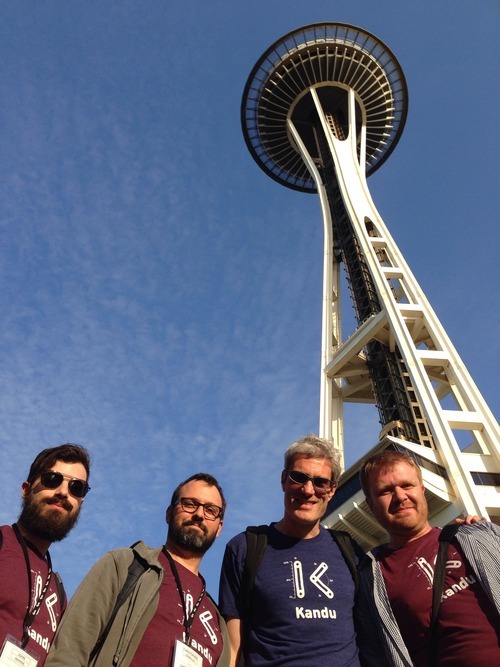#unite14
Last week, I attended the Unity3d annual conference– Unite 2014. I went with our CTO, Chris, and John and Roman, our lead Unity developers. Kandu is built using Unity, so we were eager to meet other people using Unity3d, and show folks what we’ve been working on.
We had an awesome time. The conference was in Seattle, which is a great city. (We asked ourselves– should we move from New York to Seattle!?)
Here’s a pic of the four of us in front of the Space Needle during one of the breaks. In order: John, Chris, me, Roman. Don’t ask about the T-shirt thing: the color choices were truly un-planned. Then weirdly it happened the next day (me: gray Kandu t-shirt, everyone else: blue). You can now compute what might have happened on a third day… (hint: me burgundy, everyone else gray).

Coming out of the conference, here are a few things that I’m excited about:
Everyplay: Unity announced they acquired this company. It lets people record their game session, or in our case, their Kandu session, and share the result online. Everyplay’s a great tool for creating walkthroughs, and getting help from other people. We think that in the long term, Kandu will create a community around people teaching each others how to build awesome stuff. Everyplay makes that a lot easier for everyone– our developers to build, and Kanduers to enjoy.
Thenew GUI system in Unity 4.6: One of the hardest parts of making Kandu is implementing the “graphical user interface” or GUI. This is the stuff we take for granted, like buttons, scroll bars, tabs, and other visual designs that help you navigate through software. As a game engine, Unity is optimized for making game-like experiences. But wrangling Unity to make GUI elements has been hard. This new update promises to make it easier, which means that John and Roman can spend more time building new functionality, and less time building buttons.
I also discovered that Unity has an education effort, geared to teaching people in high school and college how to program in their environment. We had a chance to exchange ideas with Michael and David from Unity– we showed them Kandu, and it seems there may be some opportunities to collaborate in our shared interest of learning how to code. We’re looking forward to seeing how this discussion evolves.
Oculus VR and Unity: like peanut butter and jelly, two great tastes that get even better together. I spent about 30 minutes playing Lucky’s Tail in VR mode. It was pretty astounding– I even got motion sickness after a while it was so immersive, from looking up and down.
Speaking of Oculus– Leap Motion demonstrated what happens when you connect a leap to an Oculus– I’ll upgrade the PB&J metaphor to smores. I put the Oculus on and saw an orb in front of me along with a pair of VR hands that corresponded to my actual hands. I grabbed the orb, and on contact it spouted rays of light. Then my hands got… hot! As if it were really happening. This demonstrated how powerfully visual cues can affect sensory perception– after all, my hands were touching nothing more than air. Chris also reported having the same sensory experience. It’ll be fascinating to see how this combo progresses.
Ultimately, we came away really impressed by how generous and smart the Unity community is– it made us feel really good about some fundamental choices we made at the start, such as what to build Kandu in. We’re excited to deepen our relationship with the Unity community, and contribute as we can over time to making it even more awesome.
David
P.S. Another awesome moment: showing Lucas Meijer, who leads engineering at Unity, what we’re up to. He made a kandu on the spot!
David is Kandu’s CEO. You can follow @dbennahum or check out his LinkedIn profile.
